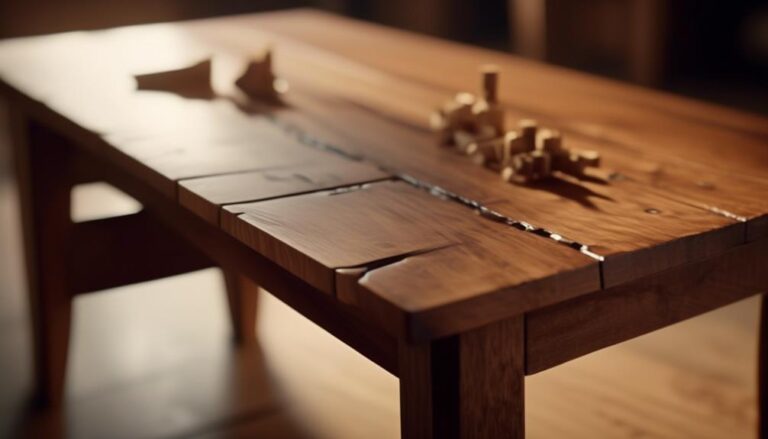Wood joinery stands as a testament to the elegance of fine woodworking, an art form where the intricate details can make or break the final piece. As you delve into the world of South African wood joinery techniques, recognized for their harmonious blend of traditional craftsmanship and an emphasis on durability, you may find yourself searching for ways to refine your skills and ensure each joint speaks to the quality of your work.
Overcoming common challenges such as achieving accurate alignment and securing strong bonds can be daunting, yet these are the very elements that elevate a project from good to exceptional.
With years steeped in the rich heritage of woodworking, this guide draws from a well of proven strategies to help you navigate the complexities of joinery. It is tailored for woodworkers who appreciate the finesse required to produce work that not only stands the test of time but also showcases the beauty of precision.
As we journey through the six essential tips, you'll uncover insights that resonate with your passion for woodworking and your desire for perfection in every joint. The path to exceptional joinery is laid before you, inviting you to explore its depths with confidence.
Continue reading, and discover how to transform the ordinary into the extraordinary.
Key Takeaways
- Consider the specific wood species and desired aesthetics for the best outcome in South African wood joinery.
- Develop a foundational understanding of traditional joinery techniques and value precision and durability.
- Utilize essential tools such as marking gauges, routers with edge guides, and hand tools for successful wood joinery.
- Precise alignment and fitting of joinery joints are fundamental for structural integrity and aesthetic finesse in South African woodworking.
Choosing the Right Wood
When selecting the right wood for your project, it is essential to consider the specific wood species and the desired aesthetics to ensure the best outcome.
Understanding the characteristics of different wood species is crucial in woodworking projects. Each type of wood possesses unique qualities that affect its workability, appearance, and durability.
For beginners, it is advisable to gather comprehensive information about various wood species before making a selection. Consider the tools and wood joinery techniques you plan to use, as some woods are more suited to specific joinery techniques than others.
Additionally, factor in the environmental conditions and the intended use of the wood to ensure stability and suitability. Moisture content and wood movement are important considerations to prevent issues like warping or splitting.
By paying attention to these details and seeking guidance from experienced woodworkers, you can make informed decisions when choosing the right wood for your woodworking projects.
This approach not only enhances the aesthetic appeal of your creations but also ensures the longevity and structural integrity of your work.
Understanding Traditional Joinery Techniques
In the realm of woodworking, a foundational understanding of traditional joinery techniques is essential for harnessing the unique qualities of different wood species and ensuring the longevity and structural integrity of your projects.
In South African wood joinery, traditional techniques are valued for their precision and durability. This includes the use of hand tools like chisels and planes for precise trimming and shaping, as well as the utilization of chisel guides, such as 90° blocks and custom-made guides, for accurate and specific angles.
Additionally, South African wood joinery emphasizes the reliance on actual boards instead of measurements, using tools like a square and marking knife for half laps. It is essential to plan carefully, considering the joint type and wood species, and to practice the techniques before important projects.
Chamfering inside edges is also common in traditional South African joinery to improve fit and reduce friction, while allowing for a slightly loose fit to accommodate wood movement. Understanding and mastering these traditional joinery techniques is crucial for creating high-quality, durable wood joinery projects in the South African woodworking tradition.
Essential Tools for South African Joinery
To achieve precision and durability in South African wood joinery, the use of specific tools is essential for mastering traditional techniques and ensuring the structural integrity of the projects. The following essential tools are indispensable for South African joinery:
- Marking Gauge: Utilize a marking gauge to precisely find the center of a board, facilitating accurate measurements and cuts for joinery.
- Router and Edge Guide: Employ a router with an edge guide for creating centered mortises, a crucial element in many South African joinery techniques.
- Hand Tools: Utilize hand tools such as router planes, rabbeting planes, and chisels for precise trimming, ensuring seamless joints and a professional finish.
These tools are fundamental for successful woodcrafting and woodworking projects. By using the right tools, South African woodworkers can ensure the accuracy, strength, and longevity of their joinery work, thereby upholding the traditional techniques and craftsmanship that are integral to South African joinery.
Mastering Joinery Joints and Fits
Mastering the precise alignment and fitting of joinery joints is fundamental to achieving the structural integrity and aesthetic finesse characteristic of South African wood joinery. Properly fitted joints ensure the longevity and durability of woodworking projects, making them essential for both functional and decorative pieces.
When mastering joinery joints and fits, it is crucial to consider the specific wood joinery techniques used in South African woodworking. These techniques often involve intricate and precise cuts, such as the use of dovetail, mortise and tenon, and half-lap joints, each requiring a different approach to achieve a perfect fit.
For beginners, it is essential to start with simpler joints before progressing to more complex ones. Practice and patience are key to honing these skills. Additionally, understanding the properties of different woods and how they respond to cutting and shaping is vital. This knowledge will inform the appropriate tools and techniques needed for achieving seamless joinery.
Finishing Touches and Maintenance
Careful attention to finishing touches and regular maintenance is essential for preserving the integrity and aesthetic appeal of South African wood joinery projects. After mastering the joinery joints and fits, it is important to focus on the final details and long-term care of your woodworking creations.
Here are some important tips for finishing touches and maintenance:
- Use the Right Tools: Quality tools are essential for achieving a professional finish. Invest in good sanding blocks, scrapers, and fine-grit sandpaper to smooth out surfaces and edges effectively.
- Protective Finishes: Apply finishes such as varnish, oil, or wax to protect the wood from moisture, UV damage, and wear and tear. This not only enhances the natural beauty of the wood but also ensures its longevity.
- Regular Maintenance: Keep your joinery projects in top condition by regularly inspecting for any signs of wear, addressing any issues promptly, and applying touch-ups to finishes as needed.
Frequently Asked Questions
What Is the Sashimono Technique?
The Sashimono technique, a hallmark of Japanese woodworking, is a method of wood joinery characterized by precision craftsmanship and handcrafted joints. It eschews nails and screws, relying on meticulous joinery aesthetics and traditional furniture.
What Are the Ancient Joinery Techniques?
Ancient joinery techniques, such as mortise and tenon, dovetail, biscuit, box joint, lap joint, bridle joint, scarf joint, halved joint, knapp joint, and tusk tenon, have stood the test of time, showcasing the craftsmanship and durability of traditional woodworking.
What Is the Traditional Joinery Method?
Traditional joinery methods are foundational in woodworking, emphasizing handcrafted joints and precise craftsmanship. These techniques have a rich history, rooted in woodworking traditions and fundamentals. Joinery tools like marking gauges and routers play a vital role in this traditional woodworking practice.
What Are the Joining Techniques for Timber?
Curious about the joining techniques for timber? There's a range of methods including mortise and tenon, dovetail, butt joint, lap joint, bridle joint, finger joint, scarf joint, pocket hole, box joint, and biscuit joint, all serving different purposes in woodworking.




